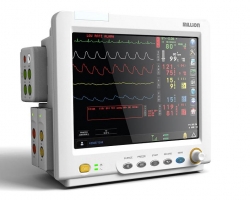Wechat QR code

TEL:400-654-1200

TEL:400-654-1200

Do you really use the ECG monitor?
ECG monitor has brought a lot of convenience to clinical work, but is it really so easy to master? Monitor manufacturers now talk about the four most commonly used items of ECG monitor.
Blood oxygen
Patients often have "very low blood oxygen" to deal with. According to the measuring principle of monitor, the reason of patient's peripheral circulation, nail polish and local skin hygiene condition will all affect the judgement of monitor. If the blood oxygen value of the patient is very low, we should observe the patient's condition, especially the local condition. When a condition is observed, the measuring curve should be observed, and a very regular curve will have reference value Meilun.
If blood oxygen is measured on the same side of the blood pressure, the measurement value will naturally decrease. If the condition is not allowed, blood oxygen should also be measured after the end of the blood pressure measurement. There is also a common case of shock and low blood pressure, because peripheral blood supply is insufficient, and peripheral blood oxygen is bound to decline.
In fact, this does not necessarily mean that patients have low blood oxygen. If the patient is clear, the question answer is correct, there is no obvious breathing difficulty, but the measured blood oxygen is very low, then don't worry about whether there is a misoperation, or whether the patient has congenital heart disease. Conversely, peripheral blood oxygen does not necessarily mean that the patient is normal. High hemoglobin is a good example.

If blood oxygen does not match the patient's condition, what can be done is three things: first, confirm whether there is a shock, the oppression of the cuff of the sphygmomanometer, the poor local skin hygiene, and other abnormal conditions, and second, the history of the disease, the exclusion of congenital heart disease, the COPD and the hypoxemia of the elderly, and third, if the cause can not be found, then make a blood gas. Analysis, at a glance, blood gas analysis as a gold indicator, can also help analyze the cause of abnormal blood oxygen.
blood pressure
Because of the measurement principle, the monitor often overestimates the "low value" and overestimates the "high", that is, if the patient's true blood pressure is 180 / 100 mm Hg, the monitor may measure 190 / 110 mm Hg; if the patient's blood pressure is 70 / 40 mm Hg, the measure may be 60 / 30 mm Hg. In addition, the width and the tightness of the cuff will affect the judgement.
There is another reason why it is easy to ignore: "automatic measuring intervals are too close", such as 10 minutes, 15 minutes, sometimes even 5 minutes. Of course, in the use of sodium nitroprusside, Ya Ning and other antihypertensive drugs to control blood pressure, or in the rescue of shock, liquid recovery, it is necessary to do this in a short time.
The treatment is simple: look at the instructions for the monitor. General instruments will mark the measurement range of blood pressure. If it is out of range, take the stethoscope and sphygmomanometer honestly and test it yourself. In addition, save the rescue, try not to set the measuring interval too short. Besides measuring data inaccuracy, it will also bring harm to patients.
Number of breaths
This is the most "unreliable" indicator. There are many influencing factors. Generally speaking, I will combine the number of patients' breathing. In general, this index can basically be "ignored".
heart rate
Personally, this is considered to be the "most useful" indicator in a monitor. Heart rate is a barometer of the severity of many diseases, in addition to the heart infarction, arrhythmia and other serious diseases judged by heart rate waveform.
"Trouble" of heart rate waveforms: ECG monitors work differently, typically counting the number of QRS waveforms over a period of time, and then calculating the heart rate. If a patient has a premature beat, the data displayed by the monitor changes frequently. Sometimes, because of the lead or T wave height, the height of QRS and T waves may be very close, and the instrument will "erroneous" as heart rate, at this time the heart rate doubles, causing unnecessary "panic".
In addition, the waveform of ECG monitoring is generated by the analog lead, and the conventional waveform of the electrocardiogram is different (the electrocardiogram needs to be connected to the extremities, and the general monitor is only connected to the chest). So there may not be any problem with similar ST-segment elevation waveforms seen on the monitor.
Summary 3 points, easy to master ECG monitoring
1. research manuals, only when you know the ECG monitor, can you do your job well.
2., strictly regulate the operation, avoid man-made causes to measure and determine the error;
3. the most important thing is that the abnormal indicators of the monitor appear. The best way is to observe the patient's condition immediately, rather than leaving it far away, and see the doctor's advice under the instrument. We treat the disease and observe the patient. The instrument helps us diagnose, and must not be diagnosed by the instrument.